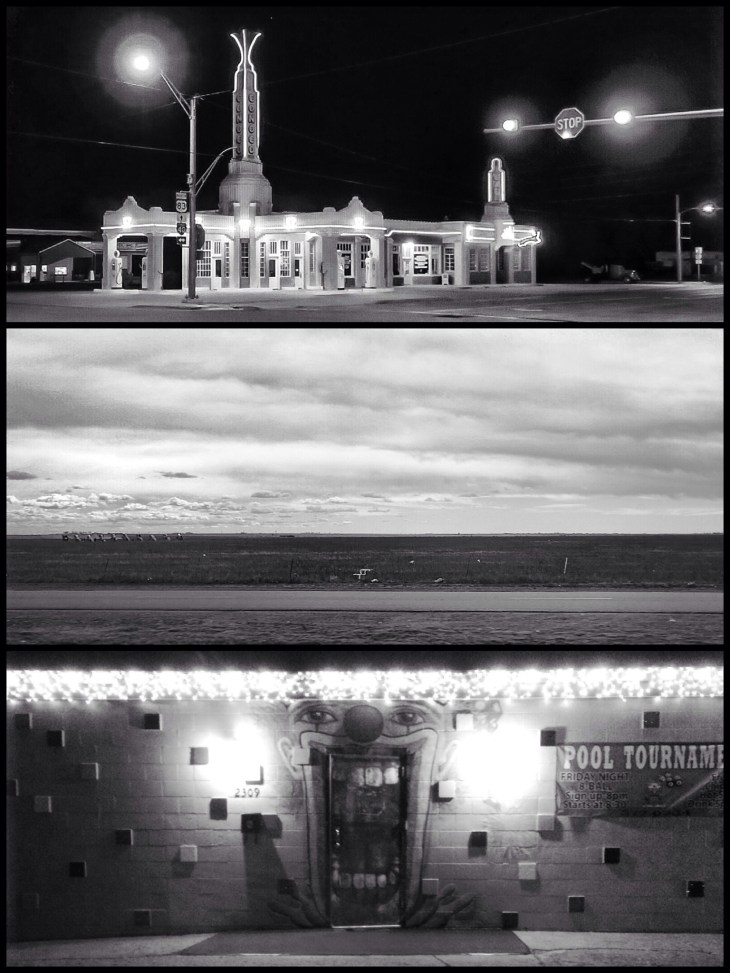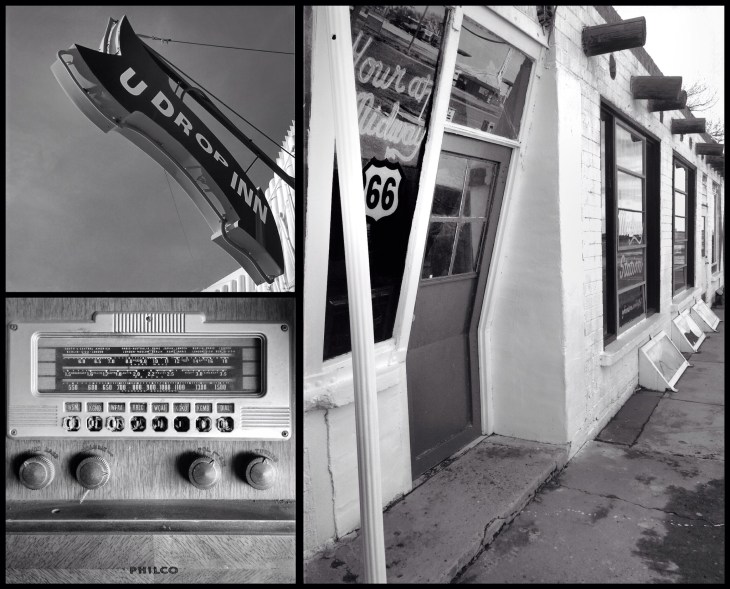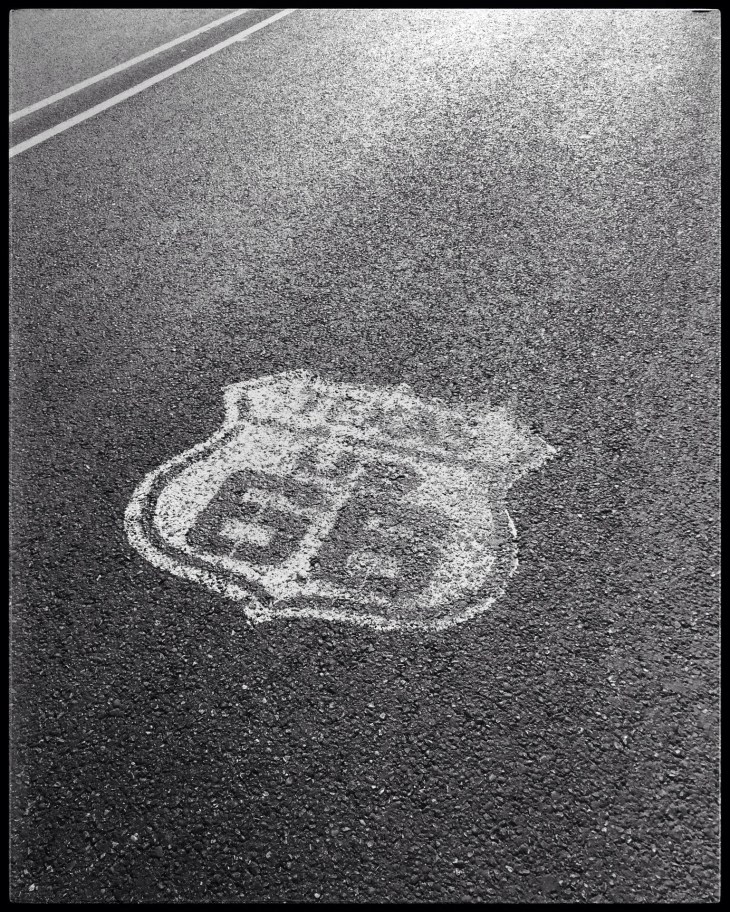Remember how I said that I was disappointed in how Texas has failed to maintain much of our Rt66 history and landmarks? (See post “Preface to Route 66.) Here’s what I meant: 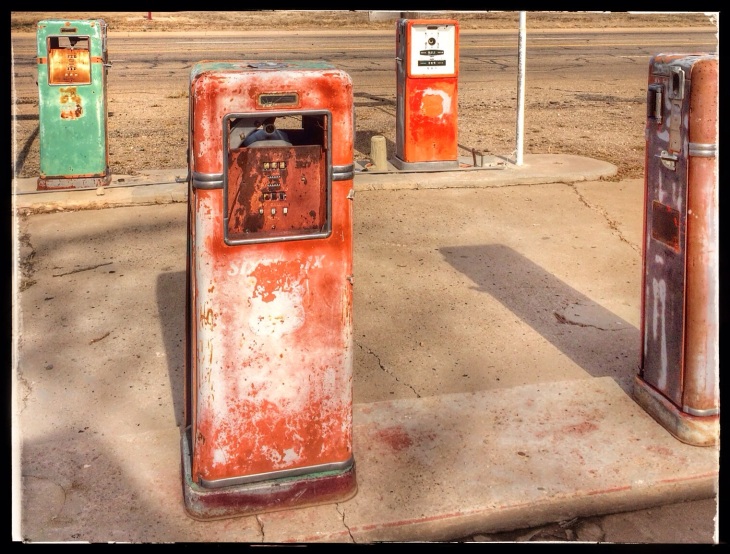 Among the disappointments on our Rt66 journey was our trip west of Amarillo to the towns of Adrian and Vega. Adrian is also known as “Midway” or “Midpoint” because it is EXACTLY half-way between Chicago and Los Angeles on Rt66–1,139 miles to either. And, we were excited to learn that the inspiration behind Flo’s V8 Cafe in the Pixar movie “Cars,” had been none other than the Midpoint Cafe in Adrian, Texas! We knew the cafe itself didn’t look like Flo’s but we’d heard that the owner and the inside were pretty awesome. Rt66 memorabilia was on display in the 1950s-esque diner, and the owner was reportedly the inspiration for FLO HERSELF! “Cars” fans in the backseat rejoiced in excitement!
Among the disappointments on our Rt66 journey was our trip west of Amarillo to the towns of Adrian and Vega. Adrian is also known as “Midway” or “Midpoint” because it is EXACTLY half-way between Chicago and Los Angeles on Rt66–1,139 miles to either. And, we were excited to learn that the inspiration behind Flo’s V8 Cafe in the Pixar movie “Cars,” had been none other than the Midpoint Cafe in Adrian, Texas! We knew the cafe itself didn’t look like Flo’s but we’d heard that the owner and the inside were pretty awesome. Rt66 memorabilia was on display in the 1950s-esque diner, and the owner was reportedly the inspiration for FLO HERSELF! “Cars” fans in the backseat rejoiced in excitement!
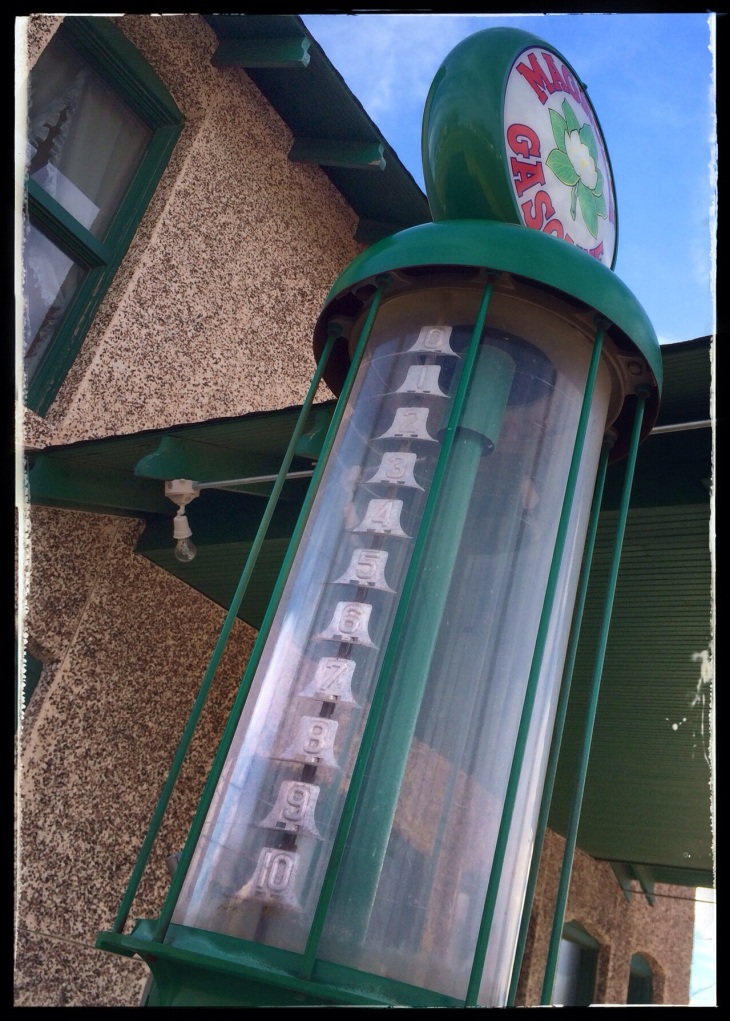 After leaving Cadillac Ranch, we went west, first to Vega. We saw some of the old neon signs– which, we learned, is what mostly remains of the Mother Road. We parked at the Courthouse and used their facilities to try to scrub the spray paint off the kiddos. No dice. My boys were blue. The paint wasn’t coming off. So we checked out the old restored Magnolia Station (pretty cool) and then headed across the street to Roark Hardware. Of all the places we stopped on our trip, Roark Hardware has got to be filled with some of the nicest people we’ve met. Not only did we want to see the oldest operating hardware store on America’s Main Street, but we needed help getting the paint off the boys. The shop was pretty neat. Filled with modern hardware items as well as some cool vintage stuff on display, Roark’s looked a lot like an old-time general store. Everyone jumped in on helping us find a way to un-paint the boys, and when we wanted to BUY the supplies, they were surprised that we didn’t just want to use some! We insisted, and left with clean kids and a happy feeling because we LOVE supporting small business.
After leaving Cadillac Ranch, we went west, first to Vega. We saw some of the old neon signs– which, we learned, is what mostly remains of the Mother Road. We parked at the Courthouse and used their facilities to try to scrub the spray paint off the kiddos. No dice. My boys were blue. The paint wasn’t coming off. So we checked out the old restored Magnolia Station (pretty cool) and then headed across the street to Roark Hardware. Of all the places we stopped on our trip, Roark Hardware has got to be filled with some of the nicest people we’ve met. Not only did we want to see the oldest operating hardware store on America’s Main Street, but we needed help getting the paint off the boys. The shop was pretty neat. Filled with modern hardware items as well as some cool vintage stuff on display, Roark’s looked a lot like an old-time general store. Everyone jumped in on helping us find a way to un-paint the boys, and when we wanted to BUY the supplies, they were surprised that we didn’t just want to use some! We insisted, and left with clean kids and a happy feeling because we LOVE supporting small business.
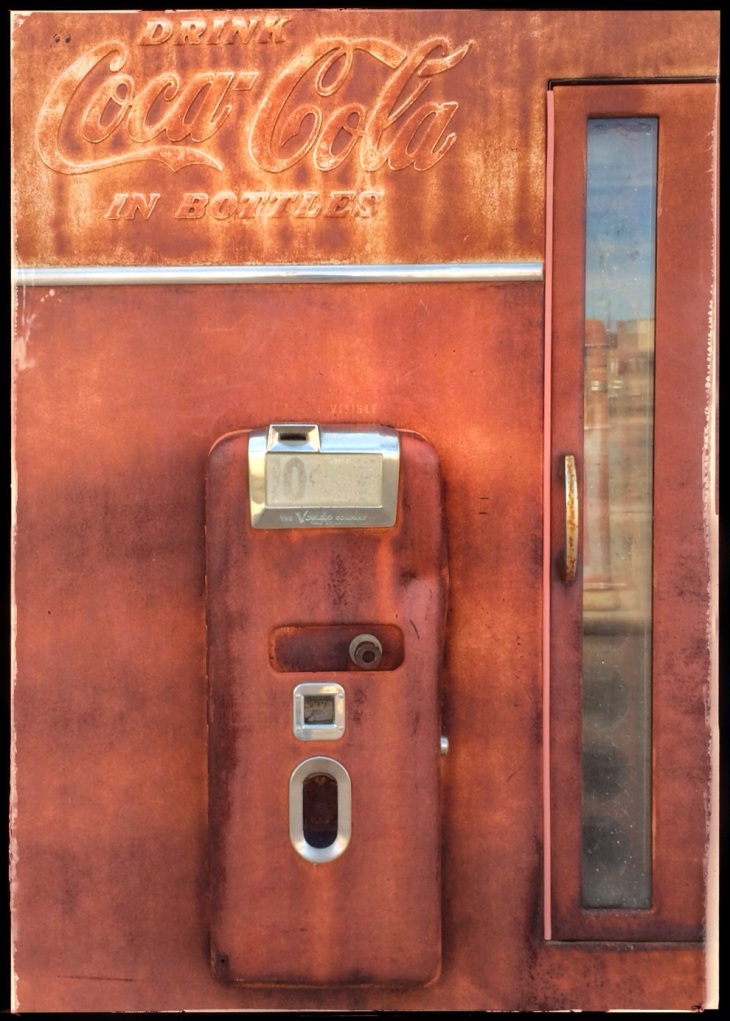 However, our joy was short-lived. Everything else in Vega was closed! Every Rt66 attraction we’d read about, every place our new friends at Roark’s recommended, everything on Trip Advisor and Yelp and our Rt66 app…. Closed. We passed up the restaurants because, well, the Midpoint Cafe was just a few miles down Rt66. So, we took some pictures around the Magnolia Station, and made our way west to Flo’s. I mean The Midpoint Cafe.
However, our joy was short-lived. Everything else in Vega was closed! Every Rt66 attraction we’d read about, every place our new friends at Roark’s recommended, everything on Trip Advisor and Yelp and our Rt66 app…. Closed. We passed up the restaurants because, well, the Midpoint Cafe was just a few miles down Rt66. So, we took some pictures around the Magnolia Station, and made our way west to Flo’s. I mean The Midpoint Cafe.
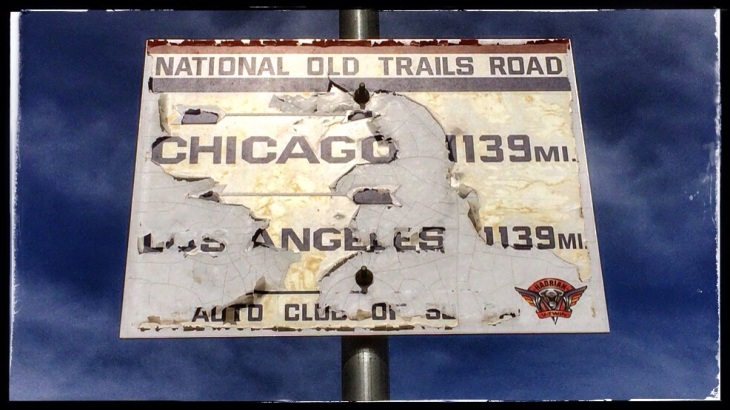 When we arrived in Adrian, we were a little surprised. (We have since learned that ANY town with a population of less than 1,000 is more than likely to be pretty sparse, so make a note for future reference!) As our second “destination city” on Rt 66 (after the county seat in Vega), we weren’t prepared for a virtual ghost town. After all, the online sites boasted 12 local businesses, a population of 150, and the Midpoint Cafe! We passed by the Bent Door Trading Post– Closed. The Antique Ranch– Gone. Tumbleweed actually blew across the road in front of us. Yet, optimistically, we pressed on. As we pulled into the parking lot at the Midpoint, our optimism quickly turned to sadness. It was closed. Closed. For the season. The handwritten sign on the door said, “Closed for the 2014 Season! SEE YOU IN JANUARY!” Sigh… (See note at the bottom.)
When we arrived in Adrian, we were a little surprised. (We have since learned that ANY town with a population of less than 1,000 is more than likely to be pretty sparse, so make a note for future reference!) As our second “destination city” on Rt 66 (after the county seat in Vega), we weren’t prepared for a virtual ghost town. After all, the online sites boasted 12 local businesses, a population of 150, and the Midpoint Cafe! We passed by the Bent Door Trading Post– Closed. The Antique Ranch– Gone. Tumbleweed actually blew across the road in front of us. Yet, optimistically, we pressed on. As we pulled into the parking lot at the Midpoint, our optimism quickly turned to sadness. It was closed. Closed. For the season. The handwritten sign on the door said, “Closed for the 2014 Season! SEE YOU IN JANUARY!” Sigh… (See note at the bottom.)

However, we did take a little “scenic” drive through the town of Adrian, and saw some hilariously strange road signs. Since they were mostly in people’s front yards (and residents looked at us like we were nuts for cruising through the residential area) I didn’t snap any pics with my Professional Fancy Candy Apple Red Picture-Making Magic Box (or the iCheese). But now I regret it because NOW I know these were some of Stanley Marsh 3’s bizarre road signs, erected in tribute to the eccentric millionaire when he died this past June. HINDSIGHT PEOPLE!!! DO YOUR RESEARCH!!! I SHOULD’VE BEEN PREPARED!
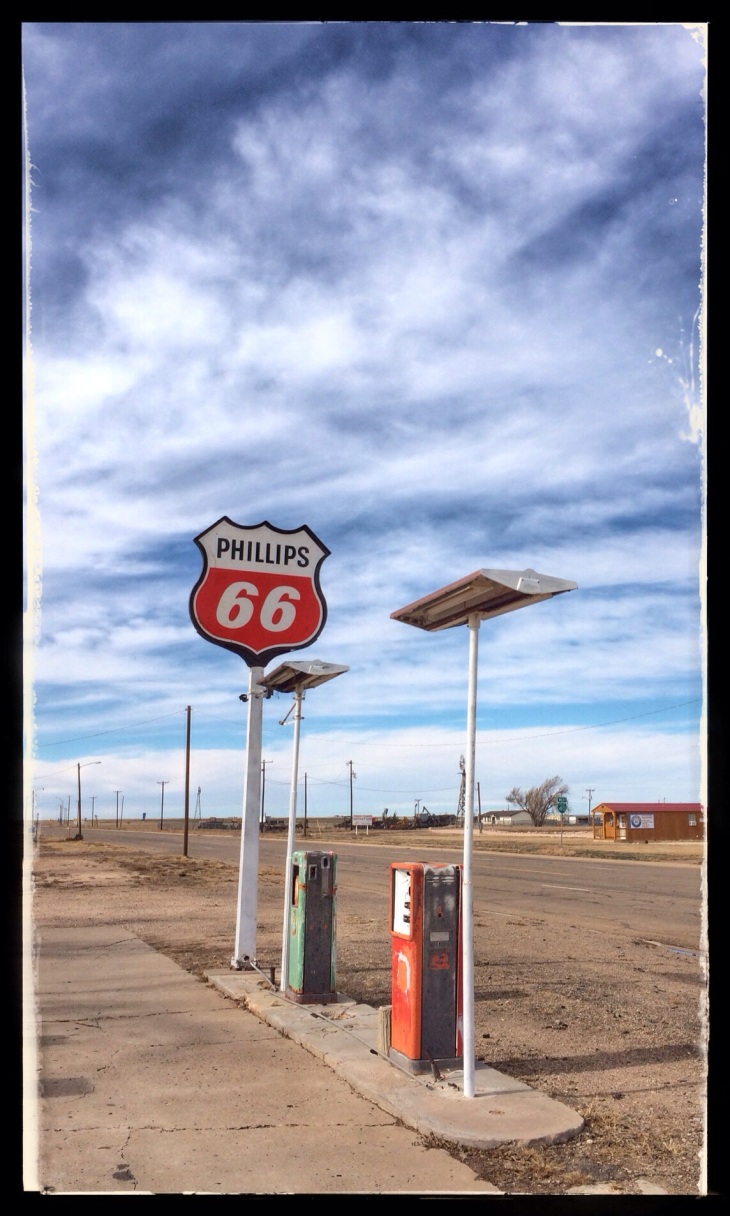 And, well, I did enjoy the Bent Door Trading Post, even though it was closed. I jumped out and took some pictures (and poked around, like I love to do in old, broken down, scary-looking, dilapidated, ghost-town looking buildings). There was some interesting “rusty gold” as Mike and Frank on American Pickers say, and the gas station fixtures out front were pretty neat. Not to mention the cool front door, which is, in fact, “bent,” as the name implies. It was originally a cafe, souvenir shop, and gas station. Built in 1947 by Robert Harris, it was actually called “Midway Station,” but everyone just called it the Bent Door Cafe” because the recycled doors and windows from a WWII USAF watch tower were “bent.” In 2009, the name was officially changed to “The Bent Door.” It had been saved from demolition, and I’d read that it was in the process of restoration, but, unfortunately, I could see no trace of this when we were there. Sad.
And, well, I did enjoy the Bent Door Trading Post, even though it was closed. I jumped out and took some pictures (and poked around, like I love to do in old, broken down, scary-looking, dilapidated, ghost-town looking buildings). There was some interesting “rusty gold” as Mike and Frank on American Pickers say, and the gas station fixtures out front were pretty neat. Not to mention the cool front door, which is, in fact, “bent,” as the name implies. It was originally a cafe, souvenir shop, and gas station. Built in 1947 by Robert Harris, it was actually called “Midway Station,” but everyone just called it the Bent Door Cafe” because the recycled doors and windows from a WWII USAF watch tower were “bent.” In 2009, the name was officially changed to “The Bent Door.” It had been saved from demolition, and I’d read that it was in the process of restoration, but, unfortunately, I could see no trace of this when we were there. Sad.
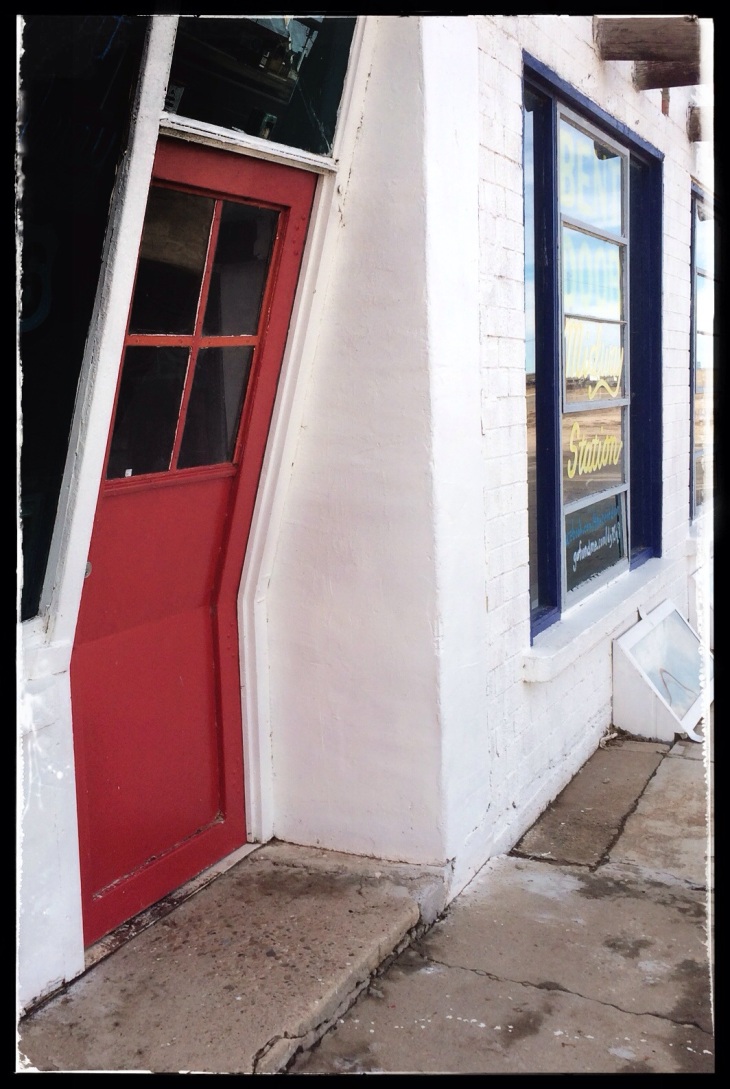 Unable to take any more disappointment, we turned the SSPhelps around and did what the Crazy Train does best….. We implemented PLAN B! The kids were STARVING (my sarcastic emphasis because apparently, the all-you-can-eat free waffles at the hotel couldn’t have sustained them for another half hour so we could see the TX/NM border) so we turned around and headed back to Amarillo, sights set on the infamous cheeseburgers of the Golden Light Cafe– CONFIRMED to be open and ready to flip some burgers!
Unable to take any more disappointment, we turned the SSPhelps around and did what the Crazy Train does best….. We implemented PLAN B! The kids were STARVING (my sarcastic emphasis because apparently, the all-you-can-eat free waffles at the hotel couldn’t have sustained them for another half hour so we could see the TX/NM border) so we turned around and headed back to Amarillo, sights set on the infamous cheeseburgers of the Golden Light Cafe– CONFIRMED to be open and ready to flip some burgers!
(END NOTE: Since we are HUGE proponents of mom and pop businesses, we applaud their decision to take a vacation! One of the best things about owning your own business is having the choice to open whenever you want. Now, we know that if there is a specific place on our “must go to” itinerary, we need to call ahead and check on the hours! Kudos, Fran Houser, for taking the holiday season off! We hope we can catch up with you next time!)

